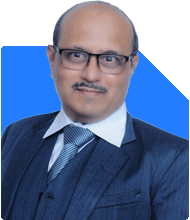Ramalingam Kalirajan |10893 Answers |Ask -Follow
Mutual Funds, Financial Planning Expert - Answered on Apr 15, 2024
He has an MBA in finance from the University of Madras and is a certified financial planner.
He is the director and chief financial planner at Holistic Investment, a Chennai-based firm that offers financial planning and wealth management advice.... more

Hi sir M 34 years old and my income is just 22k help me how to plan and save for my kids and education one is 7yrs old and one is 5yrs old and m leaving in rented house till now no investment nothing pls guide me as m going down day by day and not able to concentrate on anything and help me planning financially as i want to educate my kids well and how to invest for more income and any scholarship also let me know
Emergency Fund: Start by building an emergency fund. Aim to save at least 3-6 months' worth of expenses. This fund will provide a safety net in case of unexpected expenses or job loss.
Budgeting: Create a monthly budget to track your income and expenses. This will help you identify areas where you can cut back on expenses and save more.
Children's Education: For your children's education, consider investing in a Sukanya Samriddhi Yojana (SSY) or Public Provident Fund (PPF). These are government-backed schemes with tax benefits that can help you save for their future education.
Investments: With a monthly income of 22k, it's crucial to start small but consistent investments. Look for Systematic Investment Plans (SIPs) in mutual funds that align with your risk tolerance and investment goals. Even a small amount invested regularly can grow significantly over time.
Scholarships: Research and apply for scholarships for your children. Many organizations and educational institutions offer scholarships based on merit or financial need.
Rental House: While renting provides flexibility, consider your long-term housing needs. If possible, start saving for a down payment on a house. Owning a home can provide stability and serve as an investment for the future.
Additional Income: Explore ways to increase your income, such as taking up a part-time job or freelancing. Every extra rupee can make a difference in your savings and investments.
Remember, financial planning is a journey, not a destination. Start small, stay consistent, and review your plan regularly to make necessary adjustments. Seek advice from a financial advisor if needed to tailor a plan that suits your specific situation and goals.
You may like to see similar questions and answers below
Dev Ashish | Answer |Ask -Follow
MF Expert, Financial Planner - Answered on Jun 25, 2024
Ramalingam Kalirajan |10893 Answers |Ask -Follow
Mutual Funds, Financial Planning Expert - Answered on Jul 25, 2024
Ramalingam Kalirajan |10893 Answers |Ask -Follow
Mutual Funds, Financial Planning Expert - Answered on Feb 03, 2025
Ramalingam Kalirajan |10893 Answers |Ask -Follow
Mutual Funds, Financial Planning Expert - Answered on Aug 04, 2025
Nitin Narkhede |113 Answers |Ask -Follow
MF, PF Expert - Answered on Dec 15, 2025
Nitin Narkhede |113 Answers |Ask -Follow
MF, PF Expert - Answered on Dec 15, 2025
Ramalingam Kalirajan |10893 Answers |Ask -Follow
Mutual Funds, Financial Planning Expert - Answered on Dec 15, 2025
Ramalingam Kalirajan |10893 Answers |Ask -Follow
Mutual Funds, Financial Planning Expert - Answered on Dec 15, 2025
Radheshyam Zanwar |6746 Answers |Ask -Follow
MHT-CET, IIT-JEE, NEET-UG Expert - Answered on Dec 15, 2025
Ramalingam Kalirajan |10893 Answers |Ask -Follow
Mutual Funds, Financial Planning Expert - Answered on Dec 15, 2025
Ramalingam Kalirajan |10893 Answers |Ask -Follow
Mutual Funds, Financial Planning Expert - Answered on Dec 15, 2025
Ramalingam Kalirajan |10893 Answers |Ask -Follow
Mutual Funds, Financial Planning Expert - Answered on Dec 15, 2025
Samraat Jadhav |2508 Answers |Ask -Follow
Stock Market Expert - Answered on Dec 15, 2025
Ramalingam Kalirajan |10893 Answers |Ask -Follow
Mutual Funds, Financial Planning Expert - Answered on Dec 15, 2025
























